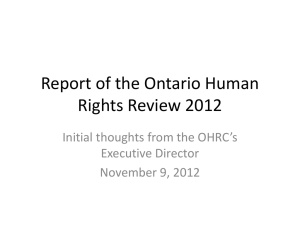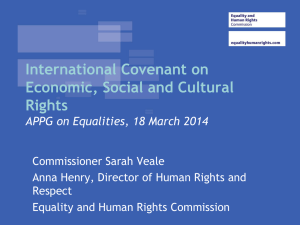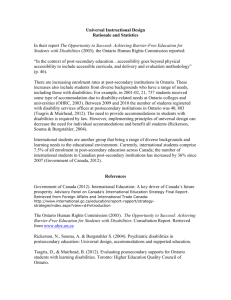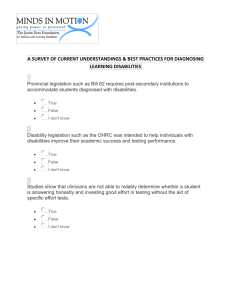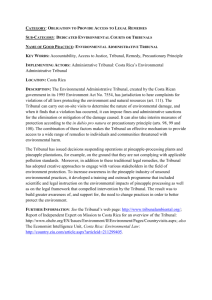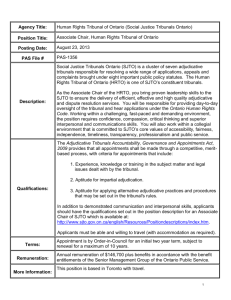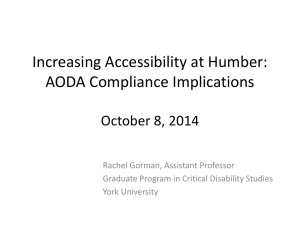human rights commission disclosure #2 jan 17
advertisement
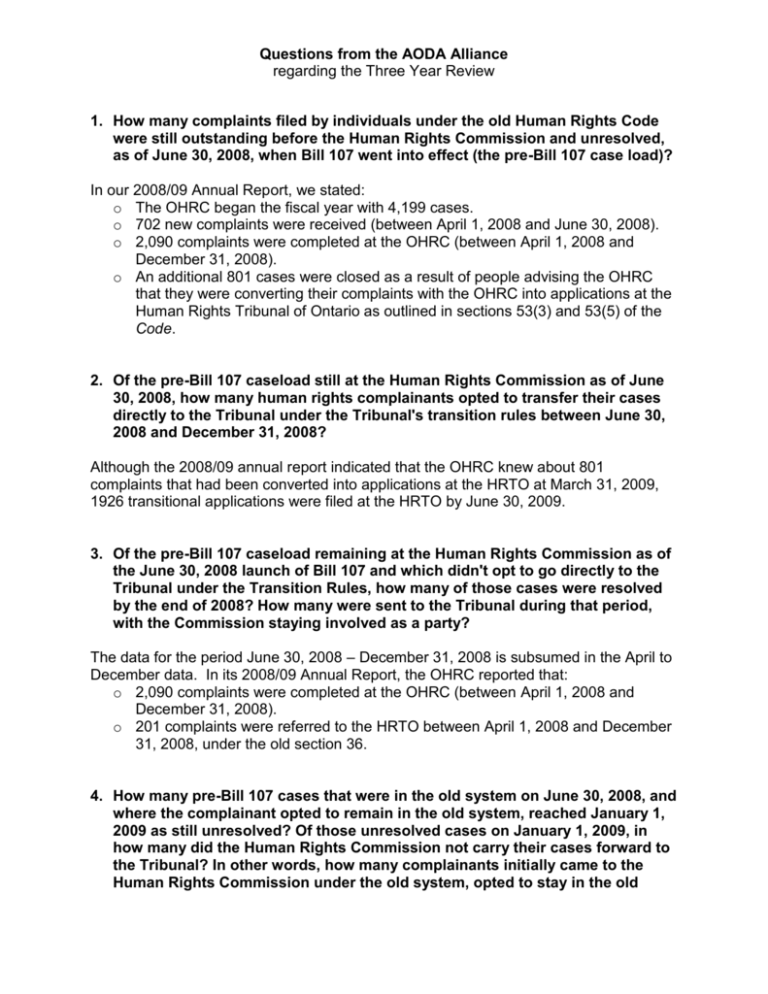
Questions from the AODA Alliance regarding the Three Year Review 1. How many complaints filed by individuals under the old Human Rights Code were still outstanding before the Human Rights Commission and unresolved, as of June 30, 2008, when Bill 107 went into effect (the pre-Bill 107 case load)? In our 2008/09 Annual Report, we stated: o The OHRC began the fiscal year with 4,199 cases. o 702 new complaints were received (between April 1, 2008 and June 30, 2008). o 2,090 complaints were completed at the OHRC (between April 1, 2008 and December 31, 2008). o An additional 801 cases were closed as a result of people advising the OHRC that they were converting their complaints with the OHRC into applications at the Human Rights Tribunal of Ontario as outlined in sections 53(3) and 53(5) of the Code. 2. Of the pre-Bill 107 caseload still at the Human Rights Commission as of June 30, 2008, how many human rights complainants opted to transfer their cases directly to the Tribunal under the Tribunal's transition rules between June 30, 2008 and December 31, 2008? Although the 2008/09 annual report indicated that the OHRC knew about 801 complaints that had been converted into applications at the HRTO at March 31, 2009, 1926 transitional applications were filed at the HRTO by June 30, 2009. 3. Of the pre-Bill 107 caseload remaining at the Human Rights Commission as of the June 30, 2008 launch of Bill 107 and which didn't opt to go directly to the Tribunal under the Transition Rules, how many of those cases were resolved by the end of 2008? How many were sent to the Tribunal during that period, with the Commission staying involved as a party? The data for the period June 30, 2008 – December 31, 2008 is subsumed in the April to December data. In its 2008/09 Annual Report, the OHRC reported that: o 2,090 complaints were completed at the OHRC (between April 1, 2008 and December 31, 2008). o 201 complaints were referred to the HRTO between April 1, 2008 and December 31, 2008, under the old section 36. 4. How many pre-Bill 107 cases that were in the old system on June 30, 2008, and where the complainant opted to remain in the old system, reached January 1, 2009 as still unresolved? Of those unresolved cases on January 1, 2009, in how many did the Human Rights Commission not carry their cases forward to the Tribunal? In other words, how many complainants initially came to the Human Rights Commission under the old system, opted to stay in the old Questions from the AODA Alliance regarding the Three Year Review system as long as possible, and then found themselves on January 1, 2009 with their cases still unresolved, but without having the Human Rights Commission available after that to investigate and publicly prosecute their case? The OHRC has never had the mandate to “publicly prosecute” cases or to “carry cases” on behalf of complainants. Before the Human Rights Code was revised, the OHRC would refer cases to the Tribunal, an adjudicative agency that provides civil (not criminal) remedies. The OHRC was a separate party from the complainant, and while its interests often aligned with those of the complainant, they did not always. Of the information requested: because transition applications were filed with the HRTO, and not with the OHRC, and complainants had no obligation to advise the OHRC of their actions, the OHRC does not have this information. 5. How many cases, filed with the Commission under the old system, simply "died" as of June 30, 2009, when the second transition period expired, due to inaction on the part of complainants who took no steps to have their complaints transferred to the Tribunal? Approximately 750 cases remained with the OHRC on June 30, 2009. Each complainant would have been sent three (3) letters advising them of the steps they were to take if they wished to transfer their file. 6. How many Commission-initiated cases had been launched under the old Code and were still at some stage of the proceedings or process when Bill 107 came on line on June 30, 2008? Of those, how many are still outstanding now, and how many were resolved, either by a hearing or settlement? The OHRC’s records do not show any active Commission-initiated complaints on June 30, 2008. 7. How many Commission-initiated applications has the Commission launched under Bill 107 since June 30, 2008? We would welcome this information on a per-year basis and as a total for the full period since Bill 107 went into effect. We would also appreciate a summary of the topic or issue each addressed, the ground of discrimination alleged, the respondent or respondents named, the year launched and the status of the case now (i.e. resolved under mediation, at a hearing or under an application for judicial review in court). The OHRC launched 3 applications in July 2009, under section 35 of the Code, dealing with discrimination in public transportation services because of disability against Hamilton, Sudbury and Thunder Bay transit providers. These applications have settled. Page 2 of 8 Questions from the AODA Alliance regarding the Three Year Review 8. How many Commission-initiated inquiries have been launched under s. 29.i of Bill 107 since June 30 2008, and in what areas? We would appreciate the same particulars on them as are listed in the previous question. Of these, in how many has the Commission used any of the investigative powers referred to in s. 29.1 of Bill 107? The Public Interest Inquiries Branch has been working on a number of public-interest issues since the Human Rights Code Amendment Act, 2006, took effect including: discriminatory housing advertisements; mental health (including inquiries dealing with mental health and housing, mental health in employment and mental health in the provision of services including healthcare services); licensing/zoning bylaws dealing with housing in various municipalities in Ontario, including Oshawa, North Bay, Toronto, Waterloo, Guelph and Smith Falls; the Toronto Police Services Board; the Windsor Police Services Board; and, transit: Grand River 9. In how many new applications launched under Bill 107 by individual applicants since June 30, 2008 has the Human Rights Commission applied to intervene before the Tribunal? In how many of these was the Commission permitted to intervene? We again would like the same particulars as in Question 7. The OHRC has intervened in the following 73 cases at the Human Rights Tribunal of Ontario: Dream Team v. Toronto (City) Gomez v. Sobeys Milton Retail Support Centre Paterno v. Salvation Army (3 cases) Demars v. Brampton Youth Hockey Association (5 cases) Shallow v. Toronto Police Services Board Claybourn v. Toronto Police Service Leong v. Peel Regional Police Services Board de Lottinville v. Ontario (Community Safety and Correctional Services) Ferguson v. Toronto Police Services Board Goodridge v. Toronto Police Services Board Seberras v. Workplace Safety and Insurance Board Morrison v. Ontario Speed Skating Association Ellis v. Petro-Canada (20 cases) Whiteley v. Osprey Media Publishing Howes v. Ontario (Municipal Affairs) XY v. Ontario (Government and Consumer Services) Woodwork v. Canadian Blood Services Page 3 of 8 Questions from the AODA Alliance regarding the Three Year Review Lawson v. Ontario (Community and Social Services) (16 cases) Rosenberg v. Richmond Hill (Town) Cochrane v. Workplace Safety and Insurance Board Carmilo v. Ottawa Police Services Board Phipps v. Toronto Police Services Board C.M. v. York Region District School Board MacDonald v. Downtown Health Club for Women de Pelham v. Mytrak Health Systems (2 cases) Johnson v. Scarborough Town Centre Holdings Inc. Aganeh Estate v. Mental Health Care Penetanguishene Marshall v. Lakeridge Health Corporation Zufeld v. Regional Municipality of Waterloo Stanley v. Toronto Police Service Fortier v. Child and Family Services of Timmins and District G.M. by her next friend J.M. v. Waterloo Catholic District School Board This does NOT included cases that the OHRC referred to the HRTO under the “old” Human Rights Code. 10. Since June 30, 2008, in how many cases has the Human Rights Commission, as a party or intervener in proceedings before the Human Rights Tribunal, used its power under section 44 of Bill 107 to require the Tribunal to consider a policy that the Commission had approved? In how many cases, if any, where the Human Rights Commission believes that the Tribunal's decision or order is inconsistent with the Commission's policy, has the Commission asked the Tribunal to state a case to the Divisional Court, as permitted by section 44.1 of Bill 107? Section 44 of Bill 107 is now section 45.5. Section 45.5 (1) states: “ In a proceeding under this Part, the Tribunal may consider policies approved by the Commission under section 30. 2006, c. 30, s. 5. Same (2) Despite subsection (1), the Tribunal shall consider a policy approved by the Commission under section 30 in a proceeding under this Part if a party to the proceeding or an intervenor requests that it do so. 2006, c. 30, s. 5.” The OHRC does not record the number of times that a party to an application or an intervenor has requested the HRTO to consider policies approved by the Commission under section 30 of the Code. Page 4 of 8 Questions from the AODA Alliance regarding the Three Year Review To date, the OHRC has not needed to apply to the HRTO to have the Tribunal state a case to the Divisional Court pursuant to section 45.6(1) of the Code. 11. What procedure does the Commission have for members of the public to ask the Commission to institute a Commission-initiated complaint or application under Bill 107, or to request an inquiry by the Commission, or to intervene in an individual's application at the Tribunal? What has the Commission done to publicize this process? How many requests has the Commission received for the Commission to launch any of these procedures, but where the Commission has declined to do so? The OHRC receives various requests from individuals and organizations to address issues respecting the Code. While we engage in as wide a range of reviews and inquiries as resources allow, we cannot fulfill all the requests we receive. General criteria on which issues should receive our attention can be found here: http://www.ohrc.on.ca/en/commission/mission/business?page=businessStrategi.html#Heading472 as part of the OHRC Business Plan. In any situation the OHRC works first to seek non-confrontational solutions such as those developed with various public sector partners: Toronto and Windsor Police Services, Ministry of Education, Ministry of Municipal Affairs & Housing and others. If such solutions are not available a Public Interest Inquiry could determine that a Commission-initiated application was appropriate. However, in recent years, we have found that most institutions we approach are willing to work cooperatively to identify and eliminate discriminatory practices and processes. Regarding Interventions: we get requests from HRLSC, from the HRTO and from individuals. We do not track requests – only interventions. 12. As you know, Bill 107 required the Commission to have a Disability Rights Secretariat and an Anti-Racism Secretariat as of June 30, 2008. Five years after Bill 107 was enacted, these have not been established, contrary to the requirements of Bill 107: a) Why have these Secretariats still not been established? s.31.3(1) and s. 31.4(1) The power to create secretariats does not rest with the OHRC. b) What steps has the Commission taken to urge the Government to establish them? The issue has been discussed with the Government of Ontario. Page 5 of 8 Questions from the AODA Alliance regarding the Three Year Review c) What steps has the Commission taken to inform the public about the circumstances of this contravention of Bill 107? The absence of secretariats has not hampered the ability of the OHRC to pursue issues of disability and racism. d) What steps has the Commission taken to implement as much of these requirements as possible on its own? Racism and disability are current priority areas of work for the OHRC, as described in our Business Plan. 13. Beyond the decisions of the Human Rights Tribunal, to what extent have the Human Rights Commission's policy guidelines, policy statements and briefs since June 2008 caused changes in human rights policies or practices in Ontario? For example, we know that in spring 2011, the Human Rights Commission commendably pressed the Ontario Government not to include in its proposed Integrated Accessibility Regulation under the Accessibility for Ontarians with Disabilities Act, a provision that any public transit vehicle (purchased with taxpayers' money) need not be accessible to persons with disabilities if purchased before July 1, 2011. We were very troubled that the Ontario Government ignored your advice, and enacted the very provision that you cautioned against. In what other areas have your new policy statements, policy guidelines or briefs since June 2008 led to actual change in practices, and in what areas have they been disregarded? How have you tracked this? The work of the OHRC is reflected in our Annual Reports. With a mandate to promote broad systemic change, the ability to measure “change in practices” over short time periods is limited. The OHRC is, however, working with partners in a variety of priority areas and seeing growing acceptance of the need to eliminate discrimination and build inclusion and accommodation into systems and organizations. 14. Is the Human Rights Commission tracking the number of public interest remedies that the Tribunal orders or that are agreed to by settlements in applications under the Code since Bill 107 went into effect? To what extent has the number or proportion of public interest remedies, ordered by the Human Rights Tribunal or included in human rights settlements, changed since Bill 107 went into effect? The OHRC does not track public interest remedies in HRTO orders and cannot in settlements because that information is not available to the OHRC. Page 6 of 8 Questions from the AODA Alliance regarding the Three Year Review 15. Can you please provide us with an updated organization chart for the Human Rights Commission, preferably in a text-based accessible format, not PDF. An updated organization chart is attached. 16. What number and designation of staff does the Commission now have available to investigate human rights issues, and to what extent has the Commission used its much-reduced power in this context? Various OHRC staff, from different units and of different designations, contribute to our expanded ability to hold public interest inquiries into human rights issues. Such inquiries are conducted as deemed necessary by the Commission. 17. Is the Human Rights Legal Support Centre sufficiently funded to meet the legal representation needs of victims of discrimination? What is the Commission's position on the appropriateness of the percentage of cases that cannot get through on the phone to the Human Rights Legal Support Centre, or that the Human Rights Legal Support Centre turns away, or to whom it cannot provide a lawyer, despite possible merit to their cases? The OHRC has no position on the funding or operations of the HRLSC. 18. To what extent is the Human Rights Commission tracking the data referred to above? The OHRC has no mandate to track HRLSC activities. 19. It is very important for community organizations like ours to see the submissions to this Independent Review that are submitted by the Tribunal, the Human Rights Commission, and the Human Rights Legal Support Centre. Indeed, we will need to see them well before we have to submit ours, and before we have the chance to present at public hearings. Will The Human Rights Commission agree to provide us and the public with your submission to the Independent Review, at least ten weeks before the time for filing submissions, and any public hearings that the Independent Review holds? Will OHRC make answers to these questions public ten (10) weeks before public hearing? The OHRC will be making written submissions to the Independent Review by its deadline of March 2012. When completed, it will be sent to Andrew Pinto and made public. Page 7 of 8 Questions from the AODA Alliance regarding the Three Year Review As a final matter, we want to let you know that we are asking the Independent Review to hold open, accessible public hearings or forums around Ontario, and to ensure that these are open to all, and not "invitation-only". We ask you to endorse our call for the Independent Review to hold these open, accessible public hearings. Andrew Pinto has said that he intends to hold open and accessible consultations. The OHRC promotes open consultation that gives people from all communities an opportunity to be heard. Page 8 of 8
